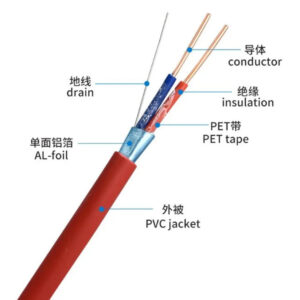Caption: Proper wire gauge selection ensures reliable fire alarm system performance.

I. Introduction
You wouldn’t use dental floss to tow a truck, would you? Yet many contractors make similar mistakes when choosing fire alarm cable gauges. The right wire size isn’t just about compliance – it’s about creating systems that save lives when seconds count. Let’s cut through the confusion with a technical yet practical guide to fire alarm cable specifications.
II. Understanding Fire Alarm Cable Basics
What Makes Fire Alarm Cables Different?
Unlike standard electrical wiring, fire alarm cables must:
- Maintain circuit integrity during fires (2-hour fire rating minimum)
- Resist electromagnetic interference (shielded designs)
- Meet strict smoke and toxicity requirements
Key Standards
| Standard | Requirement |
|---|---|
| NFPA 70 | General electrical safety |
| NFPA 72 | Fire alarm system performance |
| UL 1424 | Cable flame resistance certification |
III. Typical Wire Gauges for Fire Alarm Systems
18 AWG: The Industry Workhorse
Used in 85% of commercial installations, 18 American Wire Gauge (AWG) strikes the perfect balance between:
- Current capacity (3A max continuous load)
- Flexibility for conduit pulls
- Cost-effectiveness
Pro Tip: “For runs under 200 feet, 18 AWG is usually sufficient,” says John Martinez, ISA-certified fire safety engineer.
When to Size Up or Down
| Scenario | Recommended Gauge |
|---|---|
| Long runs (>300 ft) | 16 AWG |
| Short device leads | 22 AWG |
| High-noise environments | 14 AWG shielded |
IV. Fire Alarm Cable Gauge Selection Factors
The Distance Dilemma
Voltage drop becomes critical beyond 250 feet. Use this formula:
Voltage Drop (V) = (2 × Length × Current) / (Circular Mils × Conductivity)
Example: A 300ft run with 18 AWG (1,624 CM) carrying 100mA:
V = (2×300×0.1)/(1,624×0.98) ≈ 0.37V (acceptable for 24V systems)
Plenum vs. Riser Applications
- Plenum-rated cables (CMP): Required in air-handling spaces
- Riser-rated cables (CMR): For vertical shaft installations
V. Installation Best Practices
Termination Techniques
- Strip 3/8″ insulation using ratcheting wire strippers
- Twist stranded conductors clockwise
- Use anti-oxidant gel for copper connections
![Insert image of proper vs improper wire termination here]
Common Mistakes to Avoid
- ❌ Mixing solid and stranded wire in same circuit
- ❌ Exceeding bend radius (10× cable diameter minimum)
- ❌ Ignoring manufacturer’s pull tension limits
VI. Fire Alarm Cable Product Recommendations
Top Commercial-Grade Options
Chuanpu Cable FAP-18-2
View Specs- 18 AWG stranded copper
- Dual-layer FEP insulation
- 2-hour circuit integrity rating
Belden 9585
- 16 AWG for long runs
- Continuous flex rating
VII. FAQ Section
Q: Does wire gauge affect alarm signal transmission?
Absolutely. Undersized wires cause voltage drops that can:
- Delay notification appliance activation
- Create false “trouble” signals
- Reduce system lifespan
Q: Can I reuse existing electrical wires?
Never. Standard THHN wire lacks:
- Fire resistance ratings
- Proper shielding
- NFPA-compliant jacket materials
VIII. Conclusion
Choosing the right fire alarm cable gauge is like buying insurance – you hope to never need it, but it better work perfectly when required. While 18 AWG covers most scenarios, smart contractors always:
- Calculate voltage drop for long runs
- Verify local amendments to NFPA codes
- Test final circuit resistance
“In our hospital retrofit, upgrading to 16 AWG reduced false alarms by 40%,” reports Sarah Lin, electrical project manager at SafetyFirst Consultants.
Ready to optimize your fire alarm system?
Download our free wire gauge calculator tool
or
Request a site-specific consultation